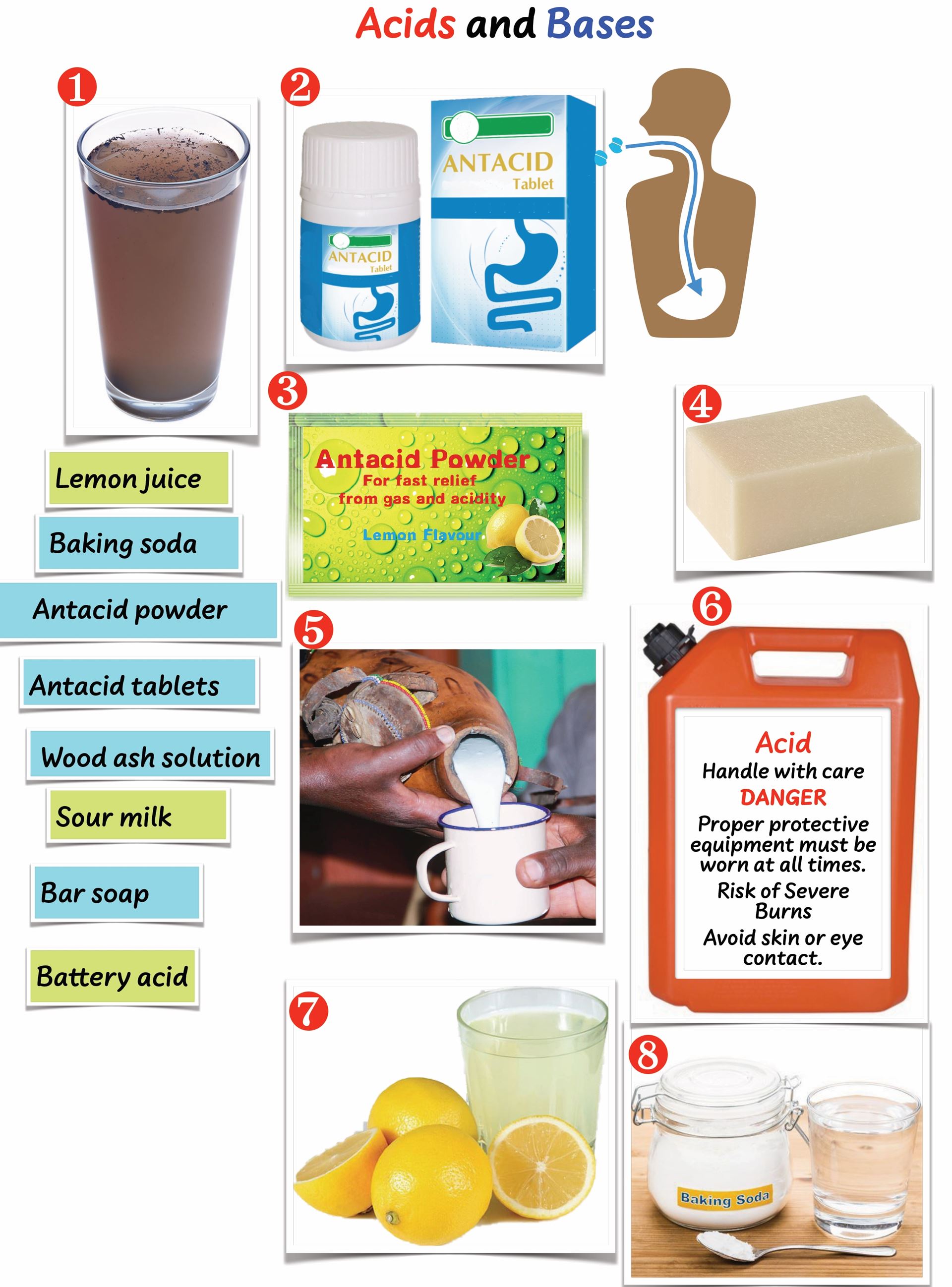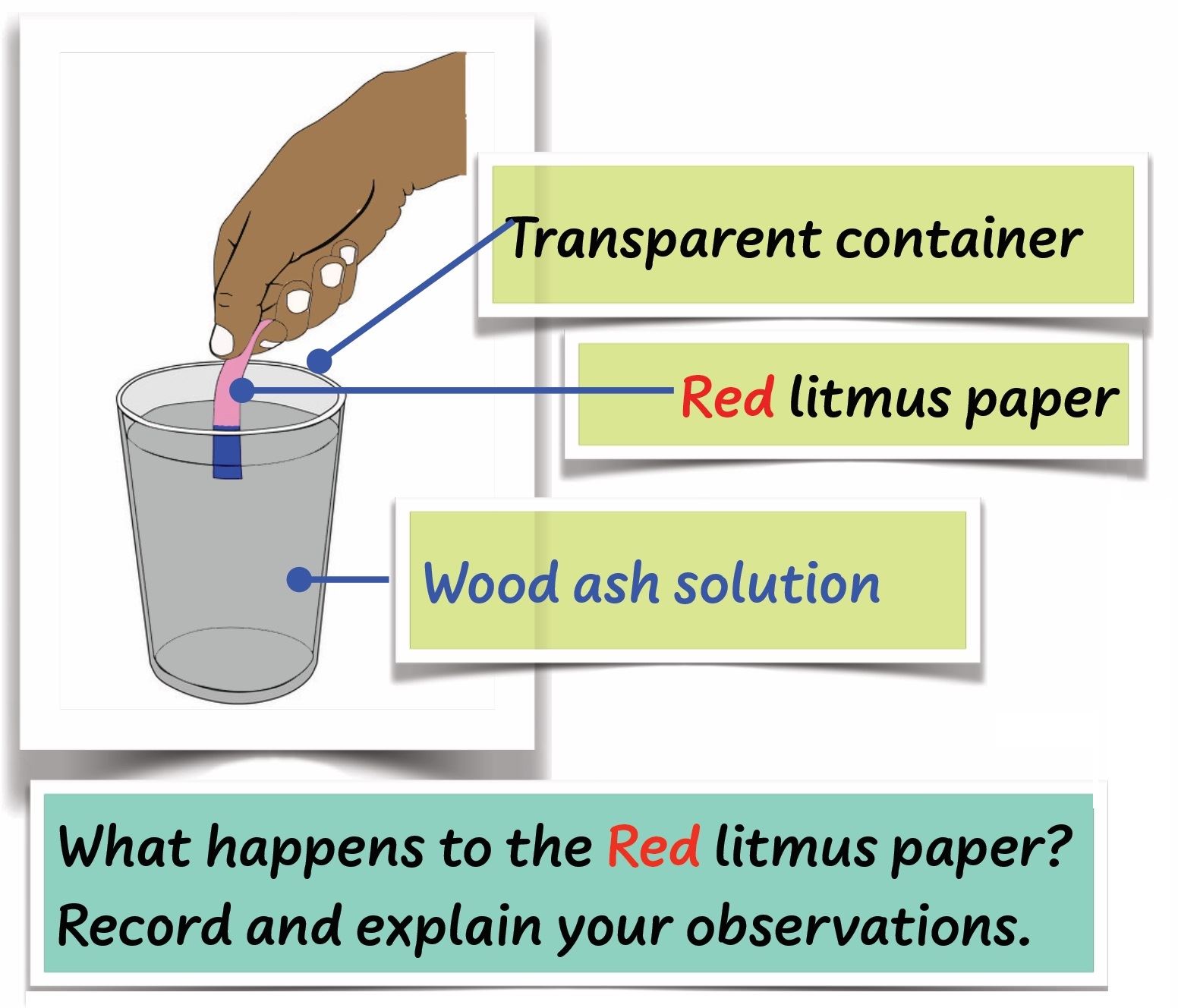Getting Ready: In our learning activities, we will:
- Use litmus paper to identify acids and bases.
- Classify commonly used substances as acids and bases.
- State the physical properties of acids and bases.
- State the uses of acids and bases in daily life.
- Observe safety precautions when handling acids and bases.
- Find out more about the following: the use of acids and bases in everyday life, and the safety precautions to apply when using acids and bases. We will share this information with others in our communities.
Activity 5.14: Learn new words
Learn the meaning of these words:
Write the words in your journal or in flashcards.
Find out their meaning. What will you use?
- A print dictionary?
- The Internet?
- Find out from friends?
- Ask parents, a guardian, or a caregiver?
- Join the English Language or the Debate Club?
How else can you find out? Share your ideas with others.
Acids and bases. What we already know?
From our earlier lessons in Hygiene and Nutrition, we learned that some foods are bitter. Others are sour. We are able to taste these foods and tell their taste. How is their taste described?
You may have heard of the term acid before. You may have also heard something being said to be acidic. You may have an idea of what these terms mean. We will learn what these terms mean in science.
Activity 5.15: Let us find out: What are acids and bases?
Work safely in groups. Use a digital device connected to the Internet to find out the meaning of acids and bases.
Examples of acids that we use everyday | Examples of bases that we use everyday |
Activity 5.16: Identifying common acids and bases
Work safely in groups. Study these pictures. Identify what is shown.

Access digital Lesson 7 on Acids and Bases on CBC Online Academy channel on YouTube.
Which substances are acids?
Name some common liquids or drinks. Which ones are sweet? Which ones have a sharp taste? What gives them the sweet or sharp taste?
All substances are made of tiny particles that behave differently. In some substances, the particles behave in a way that make them have a sweet, sharp or bitter taste. Those that have a sweet or sharp taste are acidic. Those that have a bitter taste are bases.
Acids and bases are found all around our houses. Fruit juice, soda, vinegar, and sour milk are all acids. The word acid comes from a word that means “sour.’’ Many substances such as sugar dissolve in acids.
Activity 5.17: Which substances are acids?
Discuss the pictures in Activity 5.16. Which of these materials are acids? Share your findings with others. With the guidance of your teacher, use the Internet to find out which of these substances are acids and which ones are bases.
Learn more. Grow. Share knowledge with your family and community members
What is the taste of lemonade or orange juice? They have a sharp taste. They are acidic in nature. They contain natural particles that make them acidic. Foods that are acidic have a sour or sharp taste. Besides foods, there are lots of other things that are acidic.
Which substances are bases?
In the kitchen and in the bathroom, you will find a lot of bases. Liquids such as soap gel, dish-washing liquid, bar soap, antacid tablets and powder, wood ashes dissolved in water, and baking soda are all bases.
Baking soda is bitter. If you rub it between your fingers, it has a soapy feeling.
Bases can appear soapy or bubbly. The tiny particles that they are made up of usually break down dirt and stubborn stains very well.

Activity 5.18: Which substances are bases?
Discuss the pictures in Activity 5.16. Which of these materials are bases?
Digital Lesson
Access digital Lesson 8 on Acids and Bases on CBC Online Academy channel on YouTube.
Activity 5.19: Finding out if a substance is an acid or a base
We are able to tell if a certain food is acidic or basic by tasting it. Lemonade, an acid, is sour and has a sharp taste.
Baking soda is bitter. It is a base. How do we tell whether they are acids or bases?
Learn more. Grow. Share the knowledge with your family and community members
There are different substances in nature. Some are acidic. Others are bases. It would be risky to rely on our sense of taste to tell whether they are acids or bases. What if they are poisonous? What measure do we use?
- We use an indicator to compare acids and bases.
- An indicator is a special substance that tells us whether a substance is more acidic or basic.
- There are a few natural indicators. Litmus and turmeric are examples of natural indicators.
- The most commonly used indicator in school learning activities is litmus.
- Litmus is a type of material that comes from lichens, which grow on walls, on barks of trees, and on rocks.
- Naturally, litmus has a purple colour. It changes this colour when it comes into contact with an acidic or a basic substance.
- With an acidic substance, litmus turns red. With a base, it turns blue. This special characteristic of litmus makes it a useful indicator.
- For use in learning activities, litmus is made into small sheets known as litmus papers.
- Materials that are neither basic nor acidic are said to be neutral. Pure water is an example of a neutral substance.
Access digital Lesson 9a on Acids and Bases on CBC Online Academy channel on YouTube.
Activity 5.20: How do we measure how acidic or basic a substance is?
Once we find out whether a substance is acidic or basic, in what ways can we show our findings?
Using colours to show how acidic or basic a substance is
Acids turn blue litmus red. Bases turn red litmus paper blue. We can easily use colours to show that a substance is either acidic or basic. Sort the substances listed below into acids and bases.
Activity 5.21: Using litmus paper to classify commonly used substances as acids or bases


Repeat this activity with other common substances.
Classify the substances on the following categories:


- grape juice
- bar soap solution
- orange juice
- baking powder solution
- pineapple juice
- sour milk
- powdered soap solution
- antacid tablets solution
Which category has acids? Which category has bases?
Substances that turned red litmus paper to blue are and substances that turn blue litmus paper to red are.
Learn more. Grow. Share the knowledge with your family and community members
- Solutions that change blue litmus paper to red are acids. Blue litmus paper does not change when put in a basic solution.
- Acids and bases both dissolve in water. Both acids and bases are not safe to taste or touch. They can burn your skin. Always observe safety.
- The solutions that change red litmus paper to blue are bases. Red litmus paper does not change when put in acidic solutions. It is not safe to smell acids and bases.
- One must wear protective gloves when handling acids or bases. Car mechanics wear gloves when handling car batteries.
Digital Lesson
Access digital Lesson 9 on Acids and Bases on CBC Online Academy channel on YouTube.
Acids and bases react with each other. This reaction is called neutralisation. Acids are used in manufacturing chemicals that help to keep foods for a longer period.
A common example of neutralisation is when you swallow an antacid tablet to relieve an upset stomach. There is acid in the stomach that helps with digestion. Another example is the removal of rust using acids.
Activity 5.22: Read this story
Baraka had a stomach upset while in school. The school nurse knew that the cause was acidity. She gave him some antacid tablets. He felt better.
How did the tablets work? Study pictures 1 to 3 to find out.*
* Safety kit: Do not take medicines for heartburn unless your parent or doctors says it is safe. Most antacid medicines give the age limit of 12 years and above.
Physical Properties and Uses of Acids
Uses and properties of acids and bases
Activity 5.23: Handling acids safely
Activity 5.24: Identifying the uses of acids and bases
Work safely in groups. Discuss these pictures. Answer the given questions.
Access digital Lesson 9d on Acids and Bases on CBC Online Academy channel on YouTube.


- Dissolve in water
- Slippery and slimy feeling
- Turn litmus paper red
- For making soaps
- Turn litmus paper red
- For cleaning sewage pipes
- Remove stubborn stains
- Taste bitter
- They remove rust
- They neutralise acid in the stomach
- For making bleaches that help to remove stains
- Taste sour
- Can burn skin
Be safe!
- Do not taste any materials you come across. Some are poisonous.
- Use protective clothing when handling acids and bases.
- Do not smell acids and bases.
- Bases are used for making cleaning materials such as soaps and bleaches.
- They are also used for making foods soft. An example is baking powder. It raises and softens dough. You learnt this in your Home Science lessons.
- Have you ever had indigestion? How does it feel? Tablets and powders that are used in treating indigestion are called antacids.
- Bases can be used to neutralise acidic substances.
- Pure water is neither a base nor an acid. It is neutral.
- The acid in our stomach is used to digest food.
- Some acids are used in making car batteries. They are very strong and dangerous. They will burn your skin. Do not touch.
- Some acids are used to remove rust from metallic objects.
- Some acids and bases are used for making fertilisers.
- Caution: Observe safety as you work with bases. Wear protective gloves.
Involve your family. Serve your community. Ask to find out. Learn. Share. Grow. Solve problems.
- Make a banner on safety precautions to observe when handling acidic substances. With the guidance of your parent, guardian, or caregiver, safely dispose of empty containers of acids.
- 2. Find out which local plants can be used as acid or base indicators. Some communities use bean stalk ashes to tenderise foods.
Access digital Lesson 10 on Acids and Bases on CBC Online Academy channel on YouTube.
Acid-base indicators
Project
Your parent or guardian will guide you to do this at home. Grate a piece of red cabbage and make some juice. Use it as an indicator.
Have these materials: lemon juice, orange juice, sour milk, and solutions made from bar soap, baking powder, toothpaste, atacid tablets and wood ashes
Add a small quantity of red cabbage juice to eachs solution and observe.
Record your observations. Find out what other readily available plants, flowers and vegetables you use as simple indicators. Share the information with others.
Find out from the internet how you can make your own acids and bases testing strips with paper and red cabbage juice. Try it out with the guidance of your parent, guardian or caregiver.
Digital Lesson
Access digital Lesson 11 on Acids and Bases on CBC Online Academy channel on YouTube.
Wood ashes are sprinkled on earthen floors. Find out why. Share the information with others.